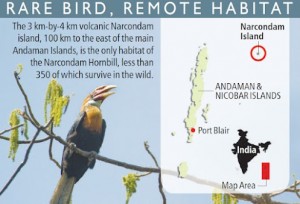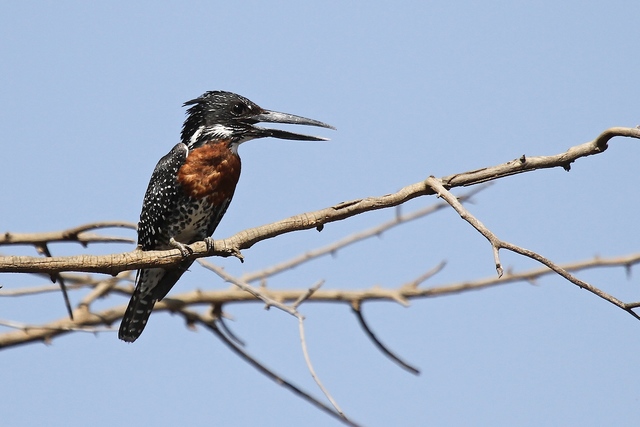 If you look for the name Narcondam in a map, it will appear as a tiny speck as part of the Andaman and Nicobar islands of India. But it is this insignificant little place that is home to one of the rarest of hornbills in the world and which might have disappeared from the planet if not for the timely plea of few conservationists and action taken by the environment ministry.
If you look for the name Narcondam in a map, it will appear as a tiny speck as part of the Andaman and Nicobar islands of India. But it is this insignificant little place that is home to one of the rarest of hornbills in the world and which might have disappeared from the planet if not for the timely plea of few conservationists and action taken by the environment ministry.
Far from the maddening urban world, in an island with an area of just 7 sq. km. the Narcondam Hornbill lived in perfect harmony with nature, until the Ministry of Defence decided to install a surveillance radar along the coastlines. In the months that ensued, the little known tiny island seemed to be slipping away from the grips of the endemic hornbill. But the Environment Ministry stepped in and has now decided to stop the project and save the bird.
Home to a Hornbill
The Narcondam Hornbill, an endemic species listed in Schedule 1 of the Wildlife Protection Act, 1972, frequents the proposed site at Narcondam Island. The International Union for Conservation of Nature (IUCN) also lists the Narcondam Hornbill as an endangered species.
It is estimated that there are less than 350 of these birds living in the island and if at all the defence project would have got the clearance, the birds would have either shifted their homes or died of the constant noise and activities.
The standing committee of the National Board of Wildlife, after a site inspection led by its member and conservationist Asad Rahmani of Bombay Natural History Society (BNHS), reported that the proposed project could wipe out the species completely.
Environment Minister Jayanthi Natarajan said,
“Even if the area to be used for the project is 0.7 hectares, disturbances and damage caused to the habitat due to laying of road and… normal functioning of the radar system is likely to cause irreversible adverse impact on this unique bird and can even wipe out the entire population,”
The Coast Guard of India has been therefore asked to look for an alternative place for the proposed radar.
Security Dilemna
It is never an easy decision to make when the question is about the country’s security. The coastal guards are planning on installing a series of such radars across the coastline of India for enhanced security surveillance. This is an important move, especially after the 26/11 terrorist attack.
 But the roadblock here was the island that is the only place in the world, where one can witness the glorious hornbills. According to experts, these birds nest on tall trees about 250 m above the ground. During nesting period, the female shed their flight feathers and are locked inside their treehouses as they tend to the young chicks.
But the roadblock here was the island that is the only place in the world, where one can witness the glorious hornbills. According to experts, these birds nest on tall trees about 250 m above the ground. During nesting period, the female shed their flight feathers and are locked inside their treehouses as they tend to the young chicks.
The radar installation would have surely disturbed the habitat and the additional human presence, roads etc. would have completely destroyed the conditions necessary for the hornbills’ survival.
Thankfully, for now, the hornbills continue to be the sole occupants of the island.
More Related Stories,
More than 100 Vultures Sighted in Himachal Pradesh
New Bird Species Discovered in Andaman and Nicobar Islands
Artificial Beaks Help save the Hornbills






4 thoughts on “Home of the Hornbills Saved from Defence Radar”